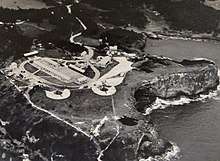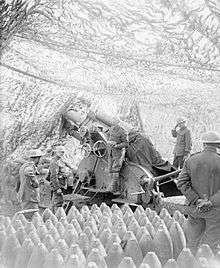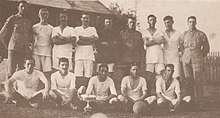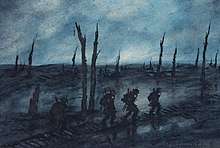Royal Garrison Artillery
The Royal Garrison Artillery (RGA) was formed in 1899 as a distinct arm of the British Army's Royal Regiment of Artillery serving alongside the other two arms of the Regiment, the Royal Field Artillery (RFA) and the Royal Horse Artillery (RHA). The RGA were the 'technical' branch of the Royal Artillery who were responsible for much of the professionalisation of technical gunnery that was to occur during the First World War. It was originally established to man the guns of the British Empire's forts and fortresses, including coastal artillery batteries, the heavy gun batteries attached to each infantry division and the guns of the siege artillery.[1] The RGA was amalgamated with the RFA in 1924, from when the only two arms within the Royal Regiment of Artillery are the Royal Artillery and the Royal Horse Artillery.
| Royal Garrison Artillery | |
|---|---|
 Officers and senior enlisted men of the Bermuda Contingent of the Royal Garrison Artillery's draft to the Western Front, during the Great War. Part of a contingent from the part-time reserve, the Bermuda Militia Artillery | |
| Active | 1899–1924 |
| Country | |
| Branch | |
| Motto(s) | Quo Fas Et Gloria Ducunt (Wherever right and glory leads) Ubique (Everywhere) |
Organisation
%2C_St._David's%2C_Bermuda_in_2011.jpg)
The Royal Garrison Artillery came into existence as a separate entity when existing coastal defence, mountain, siege and heavy batteries of the Royal Artillery were amalgamated into a new sub-branch. A royal warrant provided that from 1 June 1899:
"... the mounted and dismounted branches of the Royal Regiment of Artillery shall be separated into two corps... to be named respectively (a) the Royal Horse Artillery and the Royal Field Artillery: (b) the Royal Garrison Artillery."[2]
The Royal Regiment of Artillery, thenceforth, was divided into four branches. Other than mounted or unmounted dress, the obvious distinction in uniform was by the shoulder title badges: RA (for the branch tasked with managing ammunition dumps and supply to units in the field); RGA; RFA; and RHA.
Non-regular Royal Garrison Artillery units in Great Britain were initially found from Artillery Volunteer units, many of which were styled Royal Garrison Artillery (Volunteers) after 1902.[3] The Militia Artillery were similarly re-titled in 1902 becoming Royal Garrison Artillery (Militia).[4] After the formation of the Territorial Force in 1908, a number of RGA Volunteer units were styled Defended Ports units and were incorporated into the RGA. They were allocated to the defence of ports around Great Britain[5]
The RGA retained the badge and dress uniform (dark blue with scarlet facings) of the Royal Regiment of Artillery, but personnel were normally clothed and equipped as dismounted men. After 1920 all RGA personnel were classified as mounted men, whether serving in horse-drawn, mountain or tractor-drawn batteries,
Coast Defence


Fixed artillery (that which is not meant to move, other than for the purpose of aiming) was placed in forts and batteries in locations where they might protect potential targets (ports, cities, etc.) from attack, or from where they might prevent the advance of an enemy. This included forts and batteries intended to protect against military forces on the land, and against naval forces on the sea. Coastal artillery relied primarily on high velocity guns, capable of striking out at ships at a great distance, and penetrating their armour. Inland defensive batteries might have armament better suited for use against personnel. Mobile (field) artillery pieces were sometimes used that could be quickly re-deployed as required between fortifications that were not permanently manned or armed. Fixed batteries were operated in the early 20th century by the RGA, including its Militia Artillery and Volunteer Force reservists (often with support from other units, such as engineers operating searchlights for night-time firing).
Conventional wisdom held that a naval force would need a three-to-one advantage over coastal artillery, as the land-based artillery had the advantage of firing from a fixed platform, with resultant advantages in accuracy, especially as range increased. By the start of the 20th century, the increasing size of the capital ships of the world's largest navies, and of the guns they wielded, was already sounding the death knell of coastal artillery. As the primary armament of battleships and battle-cruisers reached 16 inches, while coastal artillery was typically 6 inch or 9 inch guns, a large naval force, including capital ships, could level coastal batteries from a range that kept them out of reach of answering fire. The advent of artillery had changed the design of fortifications centuries before, spelling the end of high-walled castles.
By the 20th century, fortifications were being designed with as much surrounding embankment by earthworks as possible. While this provided some protection from direct fire, it made defence against infantry more difficult, and did nothing to protect from high trajectory fire landing from above, or from air-bursting explosive shells, which rained the area enclosed by walls with shrapnel. In Bermuda, in the latter part of the 19th century, where the War Office had expended vast fortunes building up fortifications to protect the Royal Naval Dockyard, it was decided belatedly that the Dockyard's own fleet of naval vessels could provide a more effective defence. With the advent of the aeroplane, and the missile, fixed artillery was both obsolete and too vulnerable to continue in use. The last coastal artillery was removed from use in the 1950s.
Air Defence
The emerging need for air defence of the United Kingdom was discussed between the Admiralty and the War Office prior to the outbreak of the First World War. In August 1914 the responsibility was still split, with the Royal Garrison Artillery employing 30 officers and 312 men on air defence duties. By February 1916 the Army had entire responsibility for the air defence of the United Kingdom.[6] In May 1916 56 Companies of the RGA were created to command the guns. By November 1917 639 officers and 8,436 men of the RGA were manning anti-aircraft defences, as well as 4,309 men of the Royal Engineers and 424 men of the Army Service Corps (ASC).[7]
Mountain batteries
The mountain batteries of the Royal Artillery were also incorporated within the Royal Garrison Artillery during its existence. In 1918 there were 20 batteries which all served in India, Macedonia, Palestine and Mespotamia. Three of these batteries were raised from the Territorial Force.[8]
First World War


From 1914 when the army possessed very little heavy artillery, the RGA grew into a very large component of the British Army, being armed with heavy, large-calibre guns and howitzers that were positioned some way behind the front line and had immense destructive power.[9] With the new long-range small arms available to the infantry in the era before World War I, artillery fighting in the infantry line was increasingly vulnerable to small-arms fire. The solution to this was the principle of standing off and engaging the enemy with indirect fire. Henceforth the artillery would be positioned well behind the infantry battle line, firing at unseen targets, controlled by a forward artillery observer. Later in the war, advances in the science of gunnery enabled guns to be aimed at co-ordinates on a map calculated with geometry and mathematics. As the war developed, the heavy artillery and the techniques of long-range artillery were massively developed. The RGA was often supported by the Royal Flying Corps (RFC) who had devised a system where pilots could use wireless telegraphy to give corrections of aim to the guns. The RFC aircraft carried a wireless set and a map and after identifying the position of an enemy target the pilot was able to transmit messages such as A5, B3, etc. in Morse code to a RFC land station attached to a heavy artillery units, such as Royal Garrison Artillery Siege Batteries.[10]
The RGA significantly increased in size, especially the Heavy Batteries, which increased from 32 Regular and Territorial Force batteries in 1914 to 117 by the end of the war. The Siege Batteries increased from just three Regular batteries in 1914 to 401 by the end of the war.[11] Siege batteries (such as 9th Siege Battery at the Battle of the Somme) had the largest guns and howitzers; mounted on railways or on fixed concrete emplacements.[12]

Gunner F. J. Mears, who was medically discharged in 1917, went on to become a successful artist, painting scenes from the battlefield.[13]
Re-amalgamation
The corps name was discontinued in 1924, when the RGA was re-amalgamated into the Royal Artillery and the RGA ceased to exist as a separate entity.[14][15]
See also
- 44th Siege Battery, Royal Garrison Artillery
- 77th Siege Battery, Royal Garrison Artillery
- 94th Siege Battery, Royal Garrison Artillery
- 164th Siege Battery, Royal Garrison Artillery
- 359th Siege Battery, Royal Garrison Artillery
- 197th siege battery Royal Garrison Artillery
References
- "Royal Regiment of Artillery". Regiments.org. Archived from the original on 16 October 2007. Retrieved 31 October 2010.
- "Naval & Military Intelligence". The Times. 3 June 1899. p. 9.
- Litchfield, Norman E H, and Westlake, R, 1982. The Volunteer Artillery 1859–1908, The Sherwood Press, Nottingham, p6
- Litchfield, Norman E H, 1987. The Militia Artillery 1852-1909, The Sherwood Press, Nottingham, p6
- Litchfield, Norman E H, 1992. The Territorial Artillery 1908–1988, The Sherwood Press, Nottingham, p.3
- Farndale, Martin, 2008. History of the Royal Regiment of Artillery - The forgotten fronts and Home Base, Royal Artillery Institution, London, p362-3
- Farndale, Martin, 2008. History of the Royal Regiment of Artillery - The forgotten fronts and Home Base, Royal Artillery Institution, London, p366
- Farndale, Martin, 2008. History of the Royal Regiment of Artillery - The forgotten fronts and Home Base, Royal Artillery Institution, London, p387
- The British artillery of 1914-1918 The Long, Long Trail research site
- Harry Tabor's 1916 diary 1
- Farndale, Martin, 1986. History of the Royal Regiment of Artillery - The Western Front 1914-18, Royal Artillery Institution, London, p341
- "Details of the Siege Batteries of the RGA on Long Long Trail website"
- "Gunner F J Mears, First World War battle scene, original watercolour (Flying onions, looking towards Messines ridge)". Nicholas Holloway Fine Art. Retrieved 14 January 2020.
- "Royal Artillery Reorganized. Regiment To Form One Corps". The Times. 15 January 1924. p. 12.
A Royal Warrant dated 8 January provides that Royal Horse Artillery, Royal Field Artillery and Royal Garrison Artillery shall form one corps.
- UK Hansard, 18 February 1930
Publications
- Farndale, M. (1986). Western Front 1914–18. History of the Royal Regiment of Artillery. London: Royal Artillery Institution. ISBN 978-1-870114-00-4.
- Litchfield, Norman E H, and Westlake, R, 1982. The Volunteer Artillery 1859–1908, The Sherwood Press, Nottingham. ISBN 0-9508205-0-4
- Litchfield, Norman E H, 1992. The Territorial Artillery 1908–1988, The Sherwood Press, Nottingham. ISBN 0-9508205-2-0
- Maurice-Jones, Colonel K. W. (1959). The History of Coast Artillery in the British Army. Uckfield, E Sussex: Naval & Military Press Ltd.